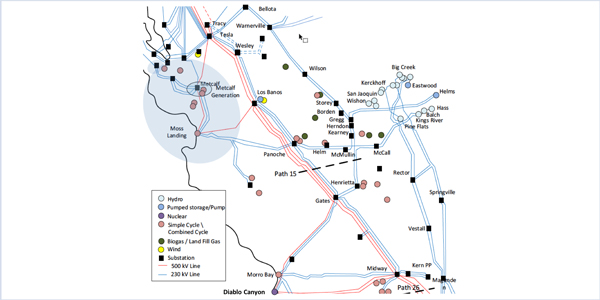By Jason Fordney
California regulators will this week vote on a proposal to replace out-of-market contracts between CAISO and Calpine, saying the ISO failed to follow its established procurement process and possibly distorted its electricity markets.
The California Public Utilities Commission’s proposed Jan. 11 decision would replace the reliability-must-run contracts for Calpine’s Metcalf, Yuba City and Feather River power plants in Northern California with energy storage and fast-acting “preferred resources” by 2019. Pacific Gas and Electric would procure the resources, which must be eligible to come online before the RMR contracts are renewed for 2019, the proposed decision says.
The commission noted that the RMR contracts were developed outside of its resource adequacy (RA) process and that CAISO’s backstop Capacity Procurement Mechanism (CPM) was not initiated before awarding the contracts.
“Lack of competition … can lead to market distortions and unjust rates for power,” the CPUC said. “It is because of this concern that the commission is exercising its broad procurement authority with this resolution to authorize PG&E to conduct the solicitation for resources that can effectively fill local deficiencies and address issues identified.”
The CAISO Board of Governors in November reluctantly approved the Metcalf RMR agreement, which was developed in an expedited timeline. (See Board Decisions Highlight CAISO Market Problems.) The board approved the Yuba City and Feather River RMRs last March, drawing some stakeholder criticism because such out-of-market payments indicate the market might not be sending appropriate price signals. (See CAISO RMRs Win Board OK, Stakeholders Critical.)
Additionally, in a Dec. 22 market notice, CAISO said it had used its CPM backstop authority for PG&E’s 510-MW Moss Landing plant in the South Bay-Moss Landing sub area and for two units at San Diego Gas & Electric’s Encinas plant in Carlsbad.
An RMR contract differs from a CPM designation in that it is involuntary for the generator, which receives a negotiated contract rate for a year. The voluntary CPM falls under a market-based price up to a cap and is riskier because the contracted megawatts can vary from month to month.
Calpine says RA capacity prices and CPM are not sufficient to sustain the plants, a claim that the CPUC has questioned. The company told CAISO in November 2016 that it planned to terminate generator interconnection agreements for the Feather River, Yuba City, King City and Wolfskill plants. In June, it told CAISO it was considering taking the 580-MW Metcalf off ISO dispatch.
In the case of Metcalf, Yuba City and Feather River, “Calpine did not enter into any bilateral RA contracts for 2018,” the CPUC said. “Instead, the company elected to communicate to the CAISO that it was planning to make these resources unavailable for CAISO dispatch unless it was awarded an RMR contract.” According to the CPUC, Calpine has said that RA capacity prices are not adequate, and that the CPM planning period does not allow sufficient time for maintenance, budget and other planning considerations.
Further complicating the situation is the fact that CAISO and Calpine are butting heads over the terms of the Metcalf, Yuba City and Feather River RMRs. CAISO and PG&E filed protests regarding the contract terms Calpine filed with FERC, which last month set the matter for settlement talks. (See FERC Orders Hearing, Settlement Talks for Calpine RMRs.)
Having noted misalignments between its processes and the CPUC’s RA program, CAISO last October launched an initiative to collaborate with the CPUC to address possible reforms. In its 2017 policy catalog, the ISO said that a rapid transformation of the fleet to more variable energy resources “is exposing inadequacies in the current resource adequacy framework.”
“I always call this a tale of two RA programs,” Carrie Bentley of Resero Consulting — which frequently represents the Western Power Trading Forum in ISO matters — told RTO Insider. She noted that the CPM model has more risk than an RMR, and that the CPUC prefers market-based outcomes rather than RMRs.
Bentley noted that the growth of community choice aggregators (CCAs) has also compounded the problem because they procure resources on an incremental basis, rather than for the full output of a plant, which is not preferable for power plant owners. CCAs allow local governments to do their own electricity procurement and have been marketed heavily in the San Francisco Bay Area as clean energy alternatives to traditional utilities.
“I think it’s a huge issue,” Bentley said. “You can’t count on building a book that way if you are a power plant owner.”
The CPUC is expected to address the CCA issue at its Thursday meeting with a recently drafted decision that would make CCAs subject to RA requirements. The proposal would better align CPUC and CAISO resource planning, the commission said. (See California Proposes Resource Adequacy Obligations for CCAs.)
CCAs have grown rapidly in California since the launch of Marin Clean Energy in 2010. Over the five following years, two new CCAs were launched serving 135,000 customers. In 2016 and 2017, 12 communities either launched new CCAs or filed implementation plans, the CPUC said.



